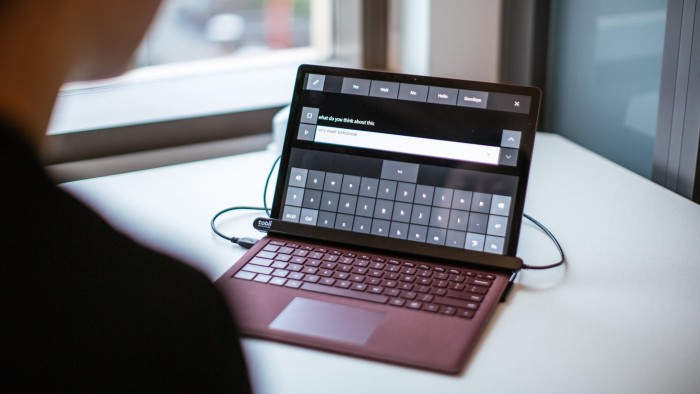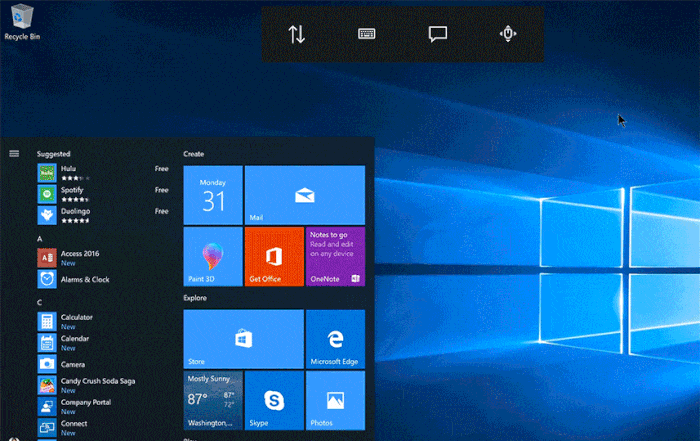Enabling tech can be catalyst for innovation that helps all

Simply sign up to the US & Canadian companies myFT Digest -- delivered directly to your inbox.
Using Microsoft’s eye-controlled technology, it is now possible for someone to operate an on-screen mouse and keyboard and a text-to-speech function using only their eyes. While the US company is developing the technology to help people with Amyotrophic Lateral Sclerosis (ALS) it can, like many innovations, help people without disabilities, too.
The reason that — armed with this technology — the eyes can become a lifeline for people with ALS is because they experience far less muscle atrophy in the eyes than in limbs. However, Jenny Lay-Flurrie, director of accessibility at Microsoft, says use of such technologies does not need to be limited to people with disabilities.
“There are definitely times when I’m multitasking far more than I should, and it would be great to just scroll up and down [using my eyes],” says Ms Lay-Flurrie. “If you design for a person with a disability, you create better stuff for everybody.”
Similarly, technologies designed for general use can be particularly useful to people with disabilities. Microsoft Translator, designed for language translation, can help people who are unable to hear, says Ms Lay-Flurrie, who is deaf.
For some people, lack of vision is the problem. Here, sensors, cameras and artificial intelligence can be combined to help blind people or those with vision loss to navigate an office space and gain a sense of the physical objects and the people in it.
For example, working with Carnegie Mellon University, IBM has developed a smartphone app called NavCog, to help people overcome difficulties in getting around, whether because of visual impairment or wheelchair use.
Unlike location-based apps that use global positioning system (GPS), high-precision location technology is a critical part of what lies behind the app. GPS-based tools can provide information on where a building is, but do not necessarily offer details such as where the entrance is located.

The NavCog app can also help with a less tangible effect of disability: the sense of isolation. Using a camera phone and technologies that include facial recognition and expression detection software, it can tell blind people things such as who is approaching them, what they are wearing and even whether or not they are smiling.
As both the IBM and Microsoft teams have found, designing for disability can be the catalyst for innovations that benefit people who have no disabilities.
Ruoyi Zhou, director of accessibility research at IBM, sees applications for technologies such as NavCog for individuals without disabilities — including for herself. “I have a terrible sense of direction,” she says. “I want the app to tell me where I’m going.”
Ms Lay-Flurrie says that many of the software tools for disabled people that are built into Microsoft Office can help others. She cites the example of Immersive Reader.
“It will read out loud what’s on the page, separate words and syllables and colour things differently,” she says. “That’s a tool that’s been developed for dyslexia but is helping others to read dense documents.”
Some argue that producing tools for people with disabilities has another benefit: that it provides a quicker route to innovation.
In normal circumstances, it can take developers considerable time watching people using a computer “to figure out what’s not working for them”, says Caricia Catalani, a director at Ideo, a global design company. “But if you watch someone with a disability for 30 minutes to an hour, it’s easier to see what’s awkward, what’s frustrating or what’s unusable and insensitive — so it’s a short-cut for us.”
Learning from the insights of people with disabilities, says Ms Lay-Flurrie, strengthens the argument for having a diverse workforce. “People with disabilities are the experts,” she says. “So by having people with disabilities in the fabric [of an organisation] you’re going to build more inclusive products.”
Many also point out that the adjustments that allow employers to help disabled staff do not have to be high-tech or costly. This is also the message of those behind the development of a new information service being put together by campaigners, to help employers in poorer countries make changes in their workplaces to accommodate disabled people at an affordable price.
“We know 80 per cent of people living with a disability are in a middle or low-income country,” says Angela Kohama, who works for the US branch of Humanity & Inclusion, the global charity formerly called Handicap International.
She argues that thousands of solutions already exist that do not require companies to install expensive new technology. These range from replacing door knobs with more graspable handles to making sure all desks have enough space between them to allow a wheelchair to pass through.
Whether her service ends up as an app or a website, the purpose is to inform employers of their options as widely as possible.
“The idea is to provide a big dictionary of reasonable accommodation solutions,” says Ms Kohama.

Comments